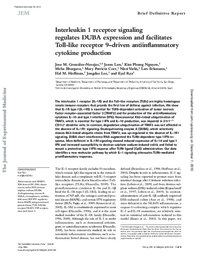Please use this identifier to cite or link to this item:
https://hdl.handle.net/11000/35482Full metadata record
| DC Field | Value | Language |
|---|---|---|
| dc.contributor.author | González-Navajas, Jose Manuel | - |
| dc.contributor.author | Law, Jason | - |
| dc.contributor.author | Nguyen, Kim Phung | - |
| dc.contributor.author | Bhargava, Meha | - |
| dc.contributor.author | Corr, Mary Patricia | - |
| dc.contributor.author | Varki, Nissi | - |
| dc.contributor.author | Eckmann, Lars | - |
| dc.contributor.author | Hoffman, Hal M. | - |
| dc.contributor.author | Lee, Jongdae | - |
| dc.contributor.author | Raz, Eyal | - |
| dc.contributor.other | Departamentos de la UMH::Farmacología, Pediatría y Química Orgánica | es_ES |
| dc.date.accessioned | 2025-01-30T07:32:48Z | - |
| dc.date.available | 2025-01-30T07:32:48Z | - |
| dc.date.created | 2010-11-29 | - |
| dc.identifier.citation | J Exp Med. 2010 Dec 20;207(13):2799-807 | es_ES |
| dc.identifier.issn | 1540-9538 | - |
| dc.identifier.issn | 0022-1007 | - |
| dc.identifier.uri | https://hdl.handle.net/11000/35482 | - |
| dc.description.abstract | The interleukin 1 receptor (IL-1R) and the Toll-like receptors (TLRs) are highly homologous innate immune receptors that provide the first line of defense against infection. We show that IL-1R type I (IL-1RI) is essential for TLR9-dependent activation of tumor necrosis factor receptor-associated factor 3 (TRAF3) and for production of the antiinflammatory cytokines IL-10 and type I interferon (IFN). Noncanonical K63-linked ubiquitination of TRAF3, which is essential for type I IFN and IL-10 production, was impaired in Il1r1(-/-) CD11c(+) dendritic cells. In contrast, degradative ubiquitination of TRAF3 was not affected in the absence of IL-1R1 signaling. Deubiquitinating enzyme A (DUBA), which selectively cleaves K63-linked ubiquitin chains from TRAF3, was up-regulated in the absence of IL-1R1 signaling. DUBA short interference RNA augmented the TLR9-dependent type I IFN response. Mice deficient in IL-1RI signaling showed reduced expression of IL-10 and type I IFN and increased susceptibility to dextran sulphate sodium-induced colitis and failed to mount a protective type I IFN response after TLR9 ligand (CpG) administration. Our data identifies a new molecular pathway by which IL-1 signaling attenuates TLR9-mediated proinflammatory responses. | es_ES |
| dc.format | application/pdf | es_ES |
| dc.format.extent | 12 | es_ES |
| dc.language.iso | eng | es_ES |
| dc.publisher | Rockefeller University Press | es_ES |
| dc.rights | info:eu-repo/semantics/openAccess | es_ES |
| dc.rights | Attribution-NonCommercial-NoDerivatives 4.0 Internacional | * |
| dc.rights.uri | http://creativecommons.org/licenses/by-nc-nd/4.0/ | * |
| dc.title | Interleukin 1 receptor signaling regulates DUBA expression and facilitates Toll-like receptor 9–driven antiinflammatory cytokine production | es_ES |
| dc.type | info:eu-repo/semantics/article | es_ES |
| dc.relation.publisherversion | 10.1084/jem.20101326 | es_ES |

View/Open:
Interleukin 1 receptor signaling regulates DUBA expression and facilitates Toll-like.pdf
3,5 MB
Adobe PDF
Share:
.png)
